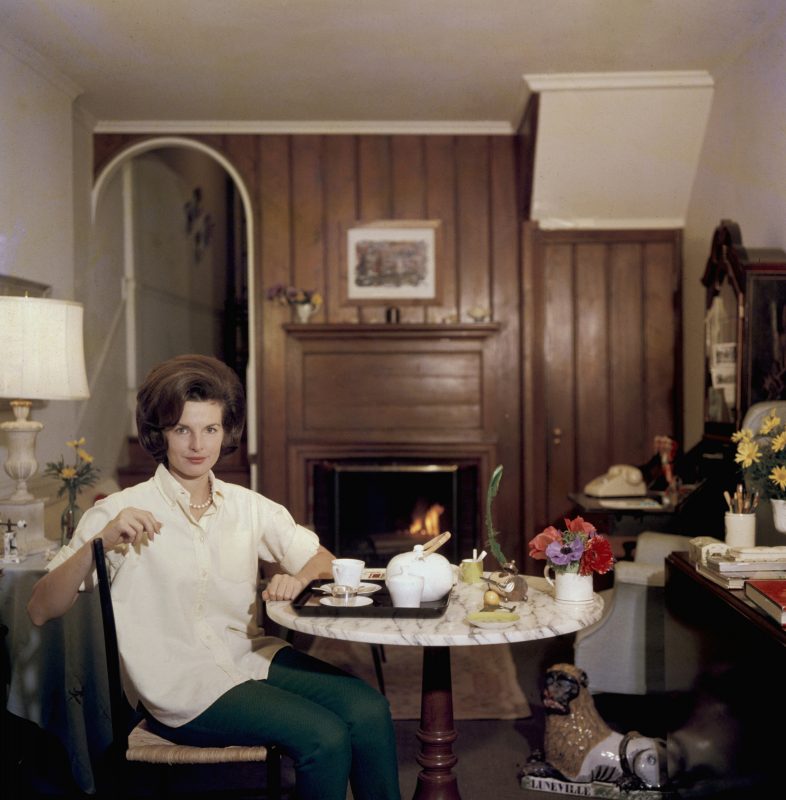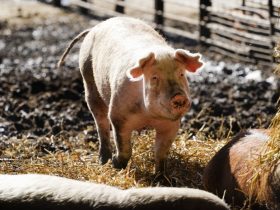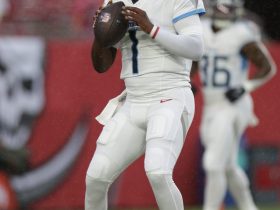A previous photo at the top of this article, which was provided by Getty Images, was flipped and depicted Pamela Turnure at right in the image. The photo has been updated.
Pamela Turnure Timmins, who served Jacqueline Kennedy as the first press secretary ever hired by a first lady, burnishing the Camelot image of sophistication and glamour while helping to usher in a media-savvy new era for the East Wing of the White House, died April 25 at her home in Edwards, Colo. She was 85.
The cause was lung cancer, said her half brother O. Burtch Drake.
Mrs. Timmins, then known as Pam Turnure, was only 23 when she began working for the Kennedy White House in January 1961, days before the president’s inauguration. Unlike her colleague Pierre Salinger, the debonair press secretary to the president himself, she had no experience in journalism, aside from a summer spent working at a magazine put out by her stepfather, the publisher of Harper’s Bazaar.
But she did have the faith and trust of the Kennedy family, whom she had known since 1957, when she met then-Sen. John F. Kennedy at the wedding of Jacqueline Kennedy’s stepsister.
Mrs. Timmins was hired as an assistant in the senator’s office and went on to work on his presidential campaign, helping type speeches, set up state campaign headquarters in Wisconsin and West Virginia, and organize an ox roast for supporters. The night of the election, she was working the phones at the Kennedy family compound on Cape Cod, gathering information on the results.
By some accounts, her relationship with John F. Kennedy extended beyond politics. Presidential chroniclers including Robert Dallek, Seymour Hersh and Barbara Leaming reported that Mrs. Timmins was one of a number of women with whom Kennedy had affairs, an assertion her family rejected.
Mrs. Timmins never commented on those allegations, according to her half brother and half sister, Deedee Howard. In interviews, they said that Mrs. Timmins had only a platonic relationship with the man she described as “the most selfless person I have ever known,” and added that she was genuinely devoted to Jacqueline Kennedy, continuing to work as her press secretary for several years after the president’s assassination in 1963.
“She answers every question exactly as I would,” the first lady wrote in a 1962 letter to a friend. “I know she will do it correctly,” she added, “so we don’t even communicate for weeks on end.”
From her second-floor office in the East Wing, Mrs. Timmins helped shape interviews, luncheons, state dinners and other public appearances by the first lady, working closely with Salinger and with Letitia Baldrige and Nancy Tuckerman, who served as successive White House social secretaries.
Mrs. Timmins was the first person to formally serve in the press secretary role, although other officials had previously helped first ladies deal with the media.
“As modern communications took off, there was a need for the first lady to have a media presence,” said Barbara A. Perry, a Jacqueline Kennedy biographer and presidential scholar at the University of Virginia. In a phone interview, she added that the first lady relied on Mrs. Timmins both “to feed the beast,” by promoting her husband’s presidency to reporters, and to “keep the beast at arm’s length,” maintaining privacy around her marriage and young children.
That attitude was summed up by a private memo Jacqueline Kennedy sent to Mrs. Timmins before the inauguration, explaining that “everyone is trying to get at us — but you will be there as a buffer.”
“My press relations,” she added, “will be minimum information given with maximum politeness.”
Mrs. Timmins carried out that edict with charm and occasional bluntness, saying that she quickly discovered the value of phrases like “no comment” and “for background only.”
At times she fielded 50 calls a day from reporters asking about the presidential family, along with answering letters asking for the first lady’s picture, autograph or favorite recipe. She pleaded with photographers to stop taking pictures of the couple’s children playing outside the White House; traveled to Europe with the first lady and president; and once introduced the media to the family’s new pet, a gray cat known as Tom Kitten.
She also attracted media attention in her own right, including in newspaper profiles that emphasized her “hazel-eyed beauty” and “dark lustrous locks.” Society columnists noted she had once dated Aly Khan, the ex-husband of Hollywood actress Rita Hayworth. “Let’s say he had a number of friends, and I was one of them,” Mrs. Timmins remarked.
For the most part, she kept the spotlight on her boss. When Jacqueline Kennedy decided to focus on restoring the White House, effectively turning the building into a museum of U.S. history, Mrs. Timmins encouraged the first lady to participate in a television special showcasing the project. She spent about four months helping her prepare for the 1962 special, which brought an estimated 80 million TV viewers inside the White House.
Mrs. Timmins later sought to ensure the first lady’s privacy during moments of tragedy, including when the Kennedys’ newborn son Patrick died in August 1963. Three months later, Mrs. Timmins was riding in the presidential motorcade in Dallas when she heard what “sounded like firecrackers,” as she later put it.
Only when her bus arrived at the Dallas Trade Mart did she learn from a reporter that the president had been shot.
“You must be kidding,” she recalled saying. “Of course it’s not true. We’ve just been in the motorcade with him.”
In a 1964 oral history released by the JFK Library after Mrs. Timmins’s death, Mrs. Timmins said that she made her way to Parkland Memorial Hospital, where she joined the first lady outside the operating room. During a period of “agonizing waiting,” she saw someone carrying a paper bag, apparently bearing the president’s personal effects. Someone else carried the pink pillbox hat that the first lady had torn off her head after her husband was shot.
Inside the hat, according to Mrs. Timmins, was a “a hair pin and a large strand of hair,” which the first lady had accidentally pulled out of her head while rushing to help her husband.
That afternoon, Mrs. Timmins and other officials were taken aboard Air Force One, where they watched as Lyndon B. Johnson was sworn in as president. The plane’s window shades had been drawn shut, and the aircraft seemed “sealed off from the outside world,” Mrs. Timmins recalled.
“You knew things were going on, other people’s lives were going on,” she said. “But on that plane time had really stopped.”
Pamela Harrison Turnure was born in Manhattan on Nov. 20, 1937. Her father, Lawrence Turnure, was a banker, and her parents divorced when she was just a few years old. She was raised by her mother, the former Louise Gwynn, and her stepfather, magazine publisher Frederic Drake.
After graduating from the Bolton girls’ school in Westport, Conn., she studied at Colby Junior College in New Hampshire and Mount Vernon Junior College in Washington, D.C., where she got a job as a receptionist at the Belgian Embassy. Then she met John F. Kennedy, then a married senator, who reportedly became a frequent visitor at her apartment.
In his 1996 book “Jack and Jackie: Portrait of an American Marriage,” journalist Christopher Andersen wrote that Mrs. Timmins’s landlords, Florence and Leonard Kater, first learned about Mrs. Timmins’s late-night guest “when they heard someone tossing pebbles at her second-floor window about 1 a.m. ‘We looked out,’ Florence Kater said, ‘and saw Senator Kennedy standing in our garden yelling, ‘If you don’t come down, I’ll climb up by your balcony.’ So she let him in.”
Mrs. Timmins’s landlords sought to discredit Kennedy during his presidential campaign, circulating a photograph that allegedly showed the senator leaving their apartment building late at night. Their efforts attracted little media attention, however, and Mrs. Timmins remained close with Jacqueline Kennedy after she left the White House, helping to manage the widowed first lady’s private office in New York.
When Mrs. Timmins married Canadian-born investment banker Robert N. Timmins in 1966, the wedding reception was held at Kennedy’s Fifth Avenue apartment. Kennedy married shipping magnate Aristotle Onassis two years later, and Mrs. Timmins went on to work as an interior decorator. After her husband’s death in 1990, she settled in Colorado.
In addition to her half siblings Drake and Howard, survivors include another half brother, William Drake.
Unlike many of her colleagues, Mrs. Timmins never wrote a memoir about her time in the White House. But she still had vivid memories of those years, beginning with the night of the inauguration, when she found herself driving journalist Joseph Alsop home after the inaugural ball.
Invited inside for a party, she helped her host cook a late-night meal of scrambled eggs and terrapin when the new president dropped by unannounced.
“It was suddenly no longer the senator or Jack, whatever people may have called him, but Mr. President,” she recalled. “And I can’t really adequately describe the electric feeling that was in that room.”








